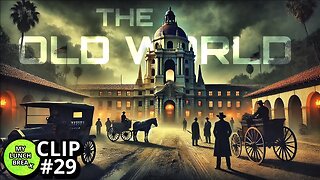Premium Only Content

Beautiful dark opal!
Opal is a hydrated amorphous form of silica, with a water content typically between 3 and 21% by weight, most commonly around 6-10%. It's deposited at relatively low temperatures and can be found in the fissures of various rock types, including limonite, sandstone, rhyolite, marl, and basalt. Here's a deeper look into opal:
Types of Opal:
Precious Opal: Known for its "play-of-color," which is an optical phenomenon where colors flash or change as the angle of light or observation changes. This effect is due to the diffraction of light through the microscopic silica spheres within the opal.
Common Opal: Lacks the play-of-color and can come in a variety of colors like white, black, grey, yellow, orange, red, or brown. It's often referred to as "potch" when not gem-quality.
Fire Opal: Typically ranges in color from yellow to orange to red and can be transparent to translucent. Fire opals can exhibit play-of-color, but their name comes from the fiery body color.
Boulder Opal: A type of opal naturally attached to its host rock. It's often cut with the host rock to provide stability and to enhance the visual appeal.
Matrix Opal: The opal fills the cracks and cavities within the host rock, creating a network of opal that's visible on the surface.
Formation:
Primary Opal: Forms through the slow deposition of silica from groundwater in cavities or fractures of rocks.
Secondary Opal: Can form by weathering or alteration of other minerals, often in more superficial environments or through the action of silica-rich waters.
Locations:
Australia: The world's leading source, especially for precious opal, with significant deposits in places like Coober Pedy, Lightning Ridge, and White Cliffs.
Ethiopia: Known for its black opals and more recently discovered opal fields.
Mexico: Famous for fire opals.
Brazil: Produces a variety of opals, including crystal opal.
Properties:
Hardness: Typically ranges between 5.5 to 6.5 on the Mohs scale, though it can be softer if less hydrated or harder if more silica-rich.
Luster: Can range from waxy to resinous to vitreous.
Transparency: Varies from opaque to semi-translucent to transparent.
-
 LIVE
LIVE
MYLUNCHBREAK CHANNEL PAGE
2 hours agoWho REALLY Built Our Cities?
600 watching -
 38:25
38:25
Rethinking the Dollar
1 hour agoWednesday Morning Check-In: Trump Media Group Joins the Bitcoin Movement
5.47K -
 1:30:06
1:30:06
Graham Allen
3 hours agoThe Border Is CLOSED!! 92% Less Crossings!! + Pete Hegseth Is GOING AFTER Mark Milley!
65.5K51 -
 13:51
13:51
Dr David Jockers
1 hour agoUltimate Fat-Burning Hack: What They Don’t Tell You!
11 -
 LIVE
LIVE
Wendy Bell Radio
7 hours agoUnapologetic
10,698 watching -
 2:09:04
2:09:04
Matt Kohrs
10 hours agoBUCKLE UP! IT'S FED RATE DAY!!! || The MK Show
23.3K3 -
 52:05
52:05
Randi Hipper
1 hour agoBITCOIN PRICE REBOUNDS AS MORE STATES REVEAL RESERVE PLANS
7.67K1 -
 33:11
33:11
BonginoReport
5 hours agoYou're the Media Now (Ep.128) - 01/29/2025
72.9K105 -
 1:00:57
1:00:57
The Crypto Report
23 hours agoBREAKING CRYPTO NEWS! (PEPE, SHIB, DOGE, SUI, SOL, BTC, HBAR, XRP, CRO)
26.2K3 -
 LIVE
LIVE
Vigilant News Network
16 hours agoBill Gates Admits MISTAKE For Cozying Up to SEX OFFENDER | The Daily Dose
740 watching